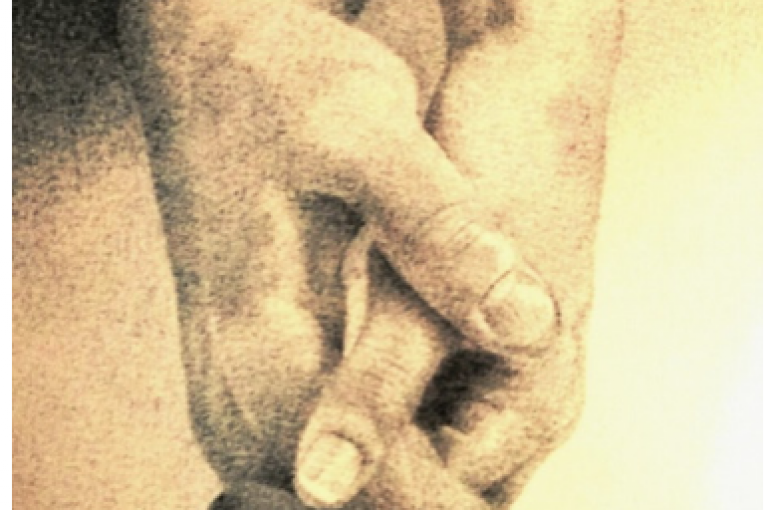
By Ghostwrite Mike & The Mundo Press

Photo Credit: Kamakazi Mergatroyd
When the incarcerated artist known as Kamakazi Mergatroyd found out his illustrated work had been chosen for publication by Columbia’s School of the Arts Literary Magazine Exchange, he was ecstatic.
The aspiring animator told us being published left him feeling “affirmed in a way few people familiar with confinement (could) appreciate because of how difficult it (is) to get this work out of the prison safely in order for it to become considered at all.”
Mergatroyd calls the piece “Lifeline” which depicts clasped hands. The artwork took him six weeks to complete through the time-intensive pointillism art style which uses micro dot impressions to render an image.
Mergatroyd completed this artwork without access to a traditional pen.
“You have to improvise and become a toolmaker in order to use the raw materials most folks might ignore, just to make art,” he said.
“In most ad-segs and the SHU (Secure Housing Unit), authorities prohibit our use of ink pens with the sturdy plastic shell housing around the inner ink filler tube, so we have to improvise by rolling paper and fashioning a makeshift (grip) that allows us to wield the instrument in order to make a true impression,” Mergatroyd explained.
Discussing his piece Mergatroyd said, “The hands are subtly but intentionally masculine in order to sublimate the different types of supportive relationships people surviving the carceral state develop.”
“I purposely avoided making the slightly smaller hand and arm as overtly feminine as convention might normally dictate, in a purposeful acknowledgement of the diversity of lifestyles found behind the wall in California,” Mergatroyd added.
Like the poet A. Van Jordan said, “if art is our depiction of history, then artists need to present accurately and inclusively, all the shades of life found here.”
Mergatroyd attributes the title of his work to his longtime friend Lewda.
“There is a special person who had been in my life for over 20 years, throughout my entire incarceration, who truly was like my lifeline – my emotional umbilical cord, as it were. I just wanted to pay homage to her tireless demonstration of unconditional love, loyalty, and friendship,” Mergatroyd stated.
The word “lifeline” comes from an underground mixtape performed by Just Cause, in which he says, “Show me ya lifeline homie, I’m speakin’ the real, before you die, fall in love, so you know how it feels to have ya heart broke.”
Contending with mental health struggles along his carceral journey, Mergatroyd admitted, “I’ve contemplated suicide countless times while serving a life term, retreated from the world in anger and abandoned my creative instincts while drowning in bouts of depression, shame and despair.”
“I’ve repeatedly lashed out at and alienated those who cared about me via these indulgent waves of aggression whereby I projected my own angst onto those who’ve always had my back. Sometimes the best apology is an image that conveys something mere words can’t,” the artist added.
The Push For Media Policy Reform
Mergatroyd described the path to export his artwork outside of Valley State Prison (VSP) as a “nightmare of obstacles.”
“The San Quentin News openly advertises how our prison’s Public Information Officer (PIO) will photograph an incarcerated artist’s work, and email the PDF to the publication. I asked to have the PIO photograph my work and VSP denied the request.
“I asked to have the local media center scan my art and save it as a PDF in order to email it out and that request was denied, too. I filed an appeal, which was denied since we have no right to digitizing services. So, I had to risk my art by snail mailing it out to the Ben Free Project’s Benjamin Frandsen who submitted it to Columbia,” he said.
An underground policy at VSP prevents residents from being able to photograph their art and send those photos home, despite the fact that the art itself is not considered contraband.
“It’s an absurd, status quo policy that prevents the photography of items deemed to be ‘props,’ which screams out to artists everywhere that at VSP (that) our freedom to make art and have it be accessible to the free world is on life support,” Kamakazi decried.
Columbia University’s Incarcerated Writers Initiative (IWI) is a pedagogical annual magazine publication curated by the School of the Arts’ MFA program that features the work of incarcerated creators.
“I feel honored to have been included. Sadly, I had to part with the piece and (had to take) the risk of mailing it out, just so it would be externally scanned and colorized. As a result, I will never again be able to hold my own work in my hands, in its original form, since, owing to yet another arcane underground policy, it cannot be mailed back in,” Mergatroyd noted.
The only way Mergatroyd may be reunited with his art is if he were to receive Colombia’s Exchange Magazine, which he is barred from because of prison regulations.
“I hope,” he said, “that can happen someday and I hope VSP corrects these draconian regulations prohibiting (the) photography of our own art. Since I own my work, what compelling penological interest justifies this inapposite restriction?”
VSP continues to prohibit residents from taking photographs of their creations. The media center continues to refuse requests to scan and digitize resident art.
“If this is California’s model of corrections and normalization is the new north star, then perhaps VSP needs a new compass,” Kamakazi concluded.
Kamakazi’s “Lifeline,” published in the Incarcerated Writers Initiative by Columbia University’s School of the Arts, can be found here.
